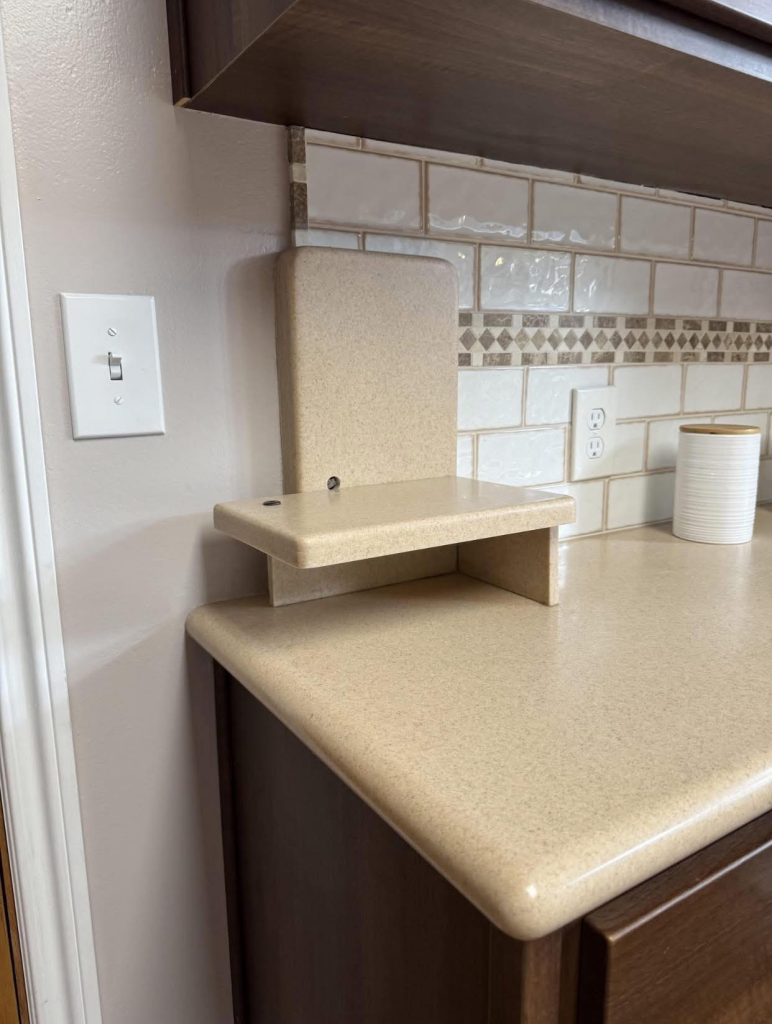The Little Shelf That Held Big Memories
Have you ever walked into an older house and stumbled upon something that instantly transported you back in time? That’s exactly what happened to me recently. I was touring a house when I noticed a tiny, oddly-placed laminate shelf in the kitchen. It was too high to reach easily, too small for storage, and definitely not decorative.
Then it hit me like a warm wave of childhood memories—that was a kitchen phone shelf.
You know the one. Usually perched right next to the fridge, maybe near a notepad with curled edges and a pen dangling from a string. And of course, the big beige corded phone with a spiral cord that could stretch across the room—or double as a tripwire for unsuspecting siblings.

The Original Command Center of the Home
That little kitchen shelf wasn’t just a slab of wood with a phone on it. It was home base. The nerve center of the house. It was where news broke, gossip flowed, and weekend plans were made. You’d find someone camped out under it, sitting on the floor, twisting the phone cord around their finger while whispering secrets to a best friend.
The phone shelf wasn’t just a utility. It was part of the family’s daily rhythm. Someone was always shouting, “I need the phone!” or “Tell them I’ll call back!” And let’s not forget that one relative who always tied up the line for hours. Long-distance phone calls were a big deal—the kind you needed permission for and whispered about before dialing.
That Iconic Phone Book and the Doodle-Filled Notepad
Under the shelf, you’d usually find the holy grail of contacts—the phone book. Heavy, yellowing, and often filled with scribbled notes, mysterious stars next to names, and the occasional kid’s doodle that somehow lasted for years. I still remember the cartoon ninja turtle my brother drew on the edge of the notepad—it became part of the shelf’s identity, like a little badge of family life.
Video: Design Of A Small Kitchen
Every house had the same accessories: a notepad for messages, a pen tied with yarn, and maybe a few magnets clinging to the wall nearby. It wasn’t organized by today’s standards, but it was real. It was used. It was alive with the noise and mess of everyday life.
When Communication Meant Being Present
There was something incredibly human about how that shelf operated. You couldn’t just tap out a message and move on. You had to be there—literally—next to the phone, listening, taking notes, and sometimes yelling across the house.
And when it rang? Everyone froze for a second. Who could it be? The excitement, the urgency—it was a moment. And if someone answered, they’d often yell, “It’s for you!” as if they’d just pulled your name out of a hat.
That kitchen phone shelf heard everything—birthday wishes, bad news, breakups, and unexpected surprises. It wasn’t just furniture. It was a silent witness to the soundtrack of family life.

The Shelf That Time Forgot
Then, slowly, technology crept in and changed everything.
Cordless phones arrived. You could suddenly walk around while chatting, phone in hand like a badge of freedom. Answering machines followed, then flip phones, and eventually smartphones. Each upgrade pulled us further away from the kitchen wall—and from the rituals that once revolved around that little shelf.
Some families removed it entirely, while others left it there, collecting dust or holding mail. But its original purpose faded. The conversations that once happened in front of it? Now replaced by emojis, short replies, and voice notes.
The shelf that once anchored the family in one shared space quietly faded into memory.
Not Just a Shelf—A Symbol of Connection
Let’s be honest. I wouldn’t add one to my modern kitchen today. I’ve got Bluetooth, FaceTime, and group chats. But there’s a part of me that aches a little when I see one still hanging around in someone else’s house.
Video: Cleaning and organising my small kitchen shelf
Because even though we’ve gained speed, convenience, and mobility, we lost something else along the way—togetherness. That kitchen phone shelf was about more than making calls. It was about sharing moments. Hearing laughter from the hallway. Catching the tail end of a joke. Scribbling a message someone would actually read because they’d pass that shelf five times a day.
Now, we miss calls, forget texts, or misread emojis. We multitask through conversations and scroll during dinner. That shelf didn’t allow for distractions. You had to be present. And maybe, just maybe, we were better for it.
Why That Shelf Still Matters
In a world where communication is faster but often shallower, the kitchen phone shelf reminds us of what we’ve traded. It stood for something simple and real: a shared space, a shared connection, a shared life.
That slab of laminate nailed to the wall wasn’t fancy. It wasn’t sleek or stylish. But it held so much. It was part of birthdays, family fights, good news, tears, laughter—and those long, lazy conversations where you said everything and nothing all at once.
It was always there. Always ready. Always steady.
Conclusion: A Tiny Shelf with a Big Heart
So the next time you walk into an older kitchen and spot one of those shelves, don’t brush it off. Pause. Remember.
That wasn’t just a random ledge—it was the pulse of a home. It was where love was passed along in “Tell Grandma I said hi.” Where responsibility was taught with “Write that message down!” And where family life unfolded, one phone call at a time.
In a world of fleeting messages and endless notifications, that little kitchen phone shelf reminds us of a time when connection was slower, deeper, and anchored to something real.
It was small, yes—but its place in our memories? Massive.